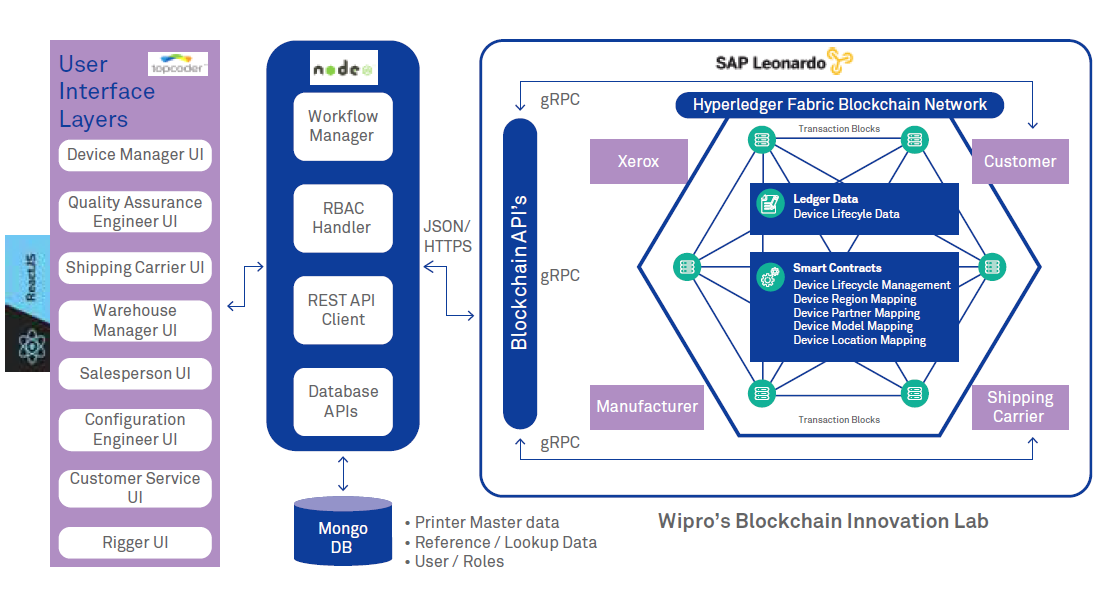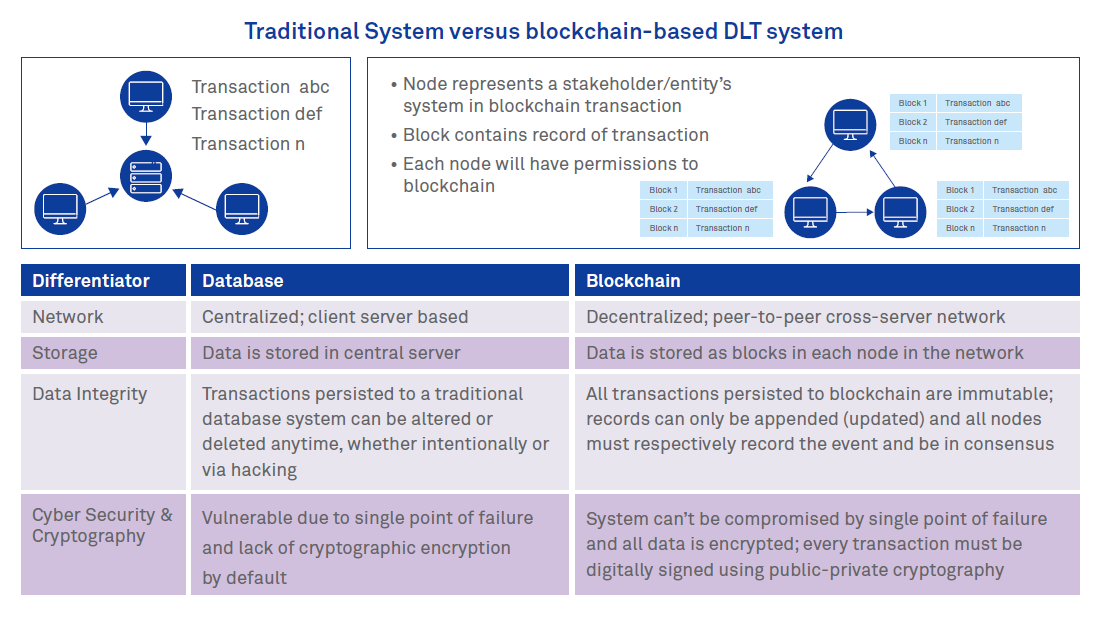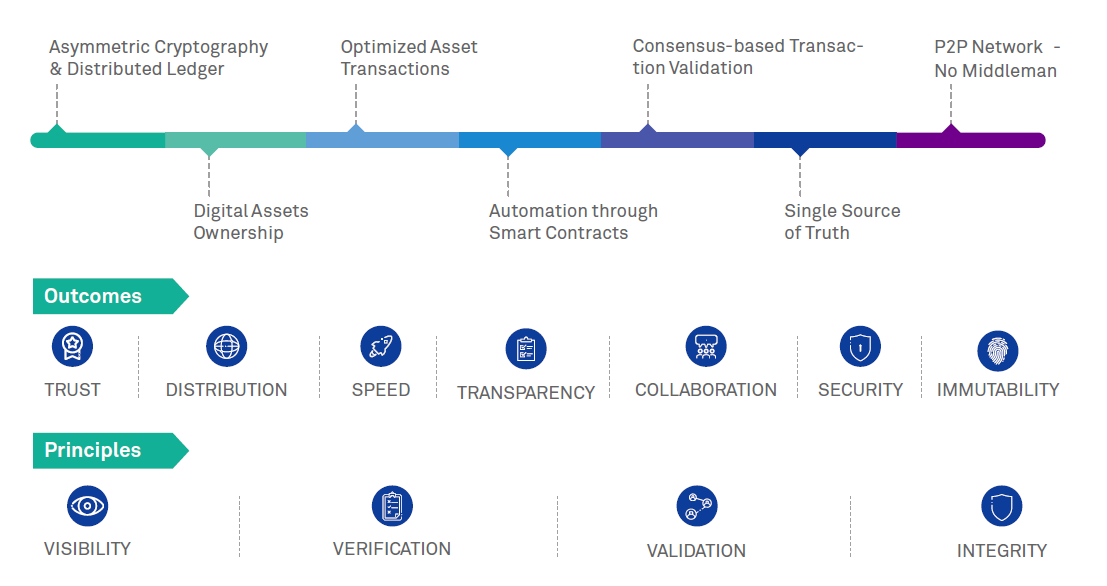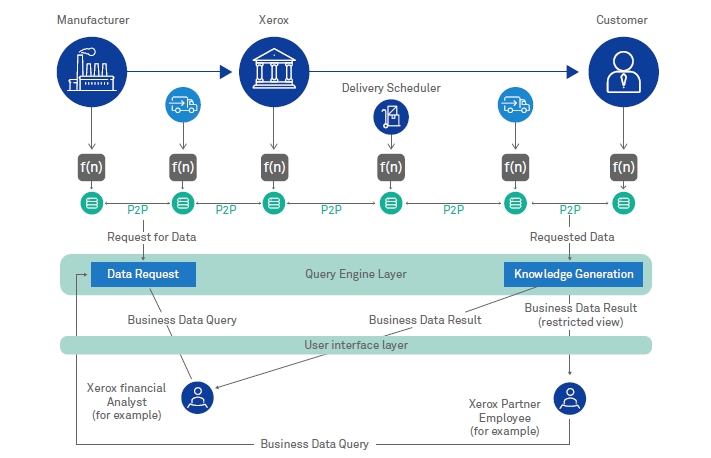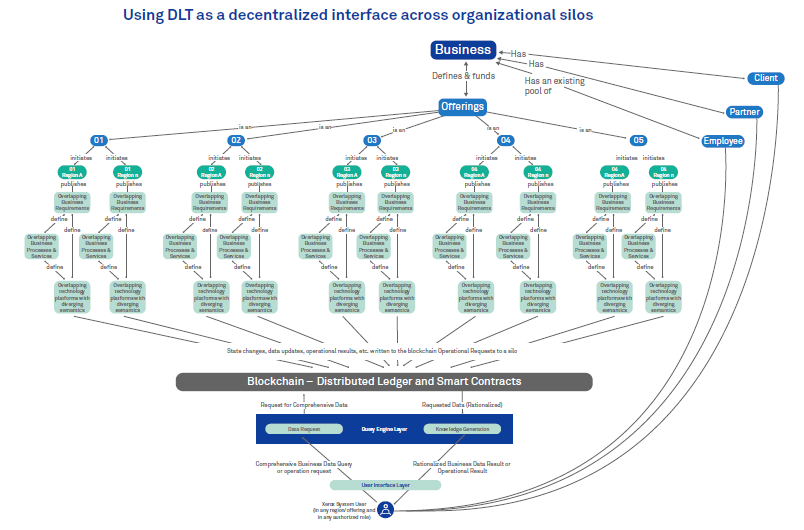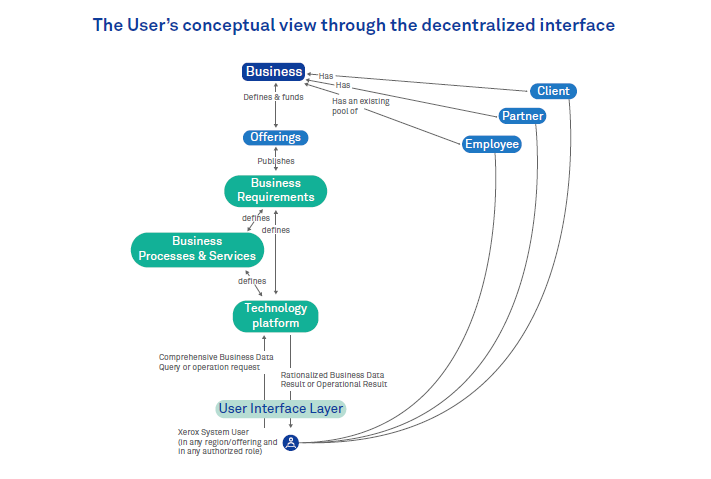The POC’s technological focus was to evaluate the values of specifically Distributed Ledger Technology (DLT) and Smart Contracts cross-database across the Xerox value chain for mid-volume printers. It demonstrates that Xerox can use blockchain’s DLT capabilities to show a single, unambiguous view of overlapping, parallel, and corresponding data stored in and across multiple systems at multiple companies by enabling an enterprise-grade distributed database architecture complimented by a new customized User Interface (UI) that would best optimize usage of these new data interaction capabilities.
From an Enterprise Architecture point of view, where you have many systems that hold the same or overlapping data, it becomes increasingly difficult to tell which data is the correct data and identifying the ‘Golden Sources’. This issue is compounded when employing systems integrated with external systems that provide vital supporting information.
The purpose of this white paper is to contextualize and share the lessons learned from this POC so as to further enable others who want to adopt blockchain-related DLT technologies. In particular, we look herein to fundamentally challenge our hypothesis: that using blockchain-related technologies cross-value chain will increase a given company’s ability for the successful Digital Transformation of their overall enterprise architecture.
A Common Problem: Trying to make it better makes it worse
With many companies, as technology bloat occurs and human understanding declines, the quality, cost, and delivery metrics of a given organization are at risk of declining at an ever-accelerating rate. Even when tightly managed and optimized, each new feature, vendor, database, and the system can reduce a company’s ability to add the next feature, vendor, database, or system and maintain the existing ones.
A typical situation faced by enterprise architects plays out as follows:
- Specific legacy system or process becomes an obvious, costly, time-consuming issue for a given business area or product line.
- The business takes action and allocates funds for a new system to be designed and implemented or procured.
- The new system is optimal and made available to the enterprise but is offered as optional and is not adopted by all regions and business lines because they are not required to and additionally they would need to spend their own budgets (e.g. to migrate or retire existing legacy systems, connect their systems’ databases to the new databases, etc.), which, in turn, they too often perceive as a penalty given the negative impact to their profit and loss (P&L) metrics.
- The new system becomes just another one among many similar systems and therefore adds to the overall complexity of the company’s Enterprise Architecture and creates more problems than it solves.
Of course, companies employ Enterprise Architecture (EA) to prevent just these types of problems and it’s the enterprise architects’ role to design and deploy coherence and simplicity throughout an organization. So why do systems decay into complexity and why can’t the enterprise architects prevent, or at least fix, these problems?
Typically, different business units, subsidiaries, and regions within a large multi-national company will have independent authority to manage the systems and vendors they use and in managing related budgets for upgrades and changes. So it is common to see decisions based more on generating near-term revenue than on seemingly costly maintenance activities or operational upgrades that will not provide a clear, understandable return in the short term. Conversely, enterprise architects typically do not have the authority to force enterprise-wise retirement, conversion, adoption, and implementation of systems regardless of the immediate or long-term technical value, nor the collective enterprise funding to be ultimately recaptured.
As issues arise due to this proliferation of redundant systems, businesses need solutions that allow various operational groups to agree on a single, trusted version of the data and a single set of systems to support each business capability. Blockchain could provide a way.
Enter blockchain: The EA enablement solution?
It has become common for people to think of blockchain as a core element for “Digital Transformation” as it is widely thought to address many of the existing limitations in increasingly complex supply chain, business service, and data management situations.
The core hypothesis has become that blockchain, most specifically DLT & Smart Contracts, can provide the basis for both saved revenue and new revenue streams by supporting new inter-system orchestrations. While it’s important to note that there are risks to deploy blockchain-based solutions at this time because the technology is immature agreed-to standards and have not yet emerged, these ‘known unknowns’ in the current landscape will most likely be resolved only via real businesses doing real testing, using, and adopting consistently over the next five-to-ten years within the realm of their overall digital transformation and enterprise architecture strategies. As Michael Jordan said, “To learn to succeed, you must learn to fail”. And while business leaders, especially Chief Information Officers and Chief Technology Officers, are pressured to digitally transform at the risk of prospective corporate demise, we are still left with questions of whether using blockchain-based protocols now will result in the addition of future costs and complexities.
But we believe that, at the end of the day, the unique abilities around decentralized database management (DLT), encryption, immutability, transparency, and work process automation (smart contracts) that blockchain enables are foundational to many core EA aspirations and are worth experimentation.
In an effort to test the viability of these outcomes, the promise of blockchain, and whether we might achieve a main goal of all enterprise architects – digital transformation – Xerox and Wipro chose a business problem to develop a blockchain-based solution that would simultaneously test a DLT protocol (the open sourced Hyperledger Fabric), Smart Contracts, a BaaS provider (SAP’s Leonardo), user interface (UI) selection and user experience (UX) development via Crowdsourcing. The following shows how an Enterprise Architecture group can make the promise of Digital Transformation and system optimization more likely using blockchain.
Why consider a blockchain-based Distributed Ledger versus a traditional centralized Database?
From a basic technology viewpoint, a DLT is a distributed database that’s used as a ledger to record business transactions that normally involve transfer of tangible or intangible assets. Each time a transaction is completed, a new “block” of information is respectively added to the blockchain’s linear chain of blocks. Each block represents a transaction and specific related data. The new block documents the important details about that new transaction and all related elements and is irrevocably linked to the previous block in the chain. If a transaction is not completed for whatever reason, no block is created. Additionally, each node in the distributed database stores an encrypted copy of the entire blockchain (database) at all times.
While much of this can be implemented with a standard distributed database, blockchain adds additional elements not normally found in traditional databases including trust in workflows where trust doesn’t exist, universal verifiability, the encrypted storage of private or sensitive data in public or more widespread databases (i.e.
hiding in plain sight), and a whole slew of new cybersecurity capabilities including consensus methodologies, immutability, and atomic operations (meaning transactions run independently of each other so no two operations can interact with or interfere with or corrupt each other).




